opening up of China
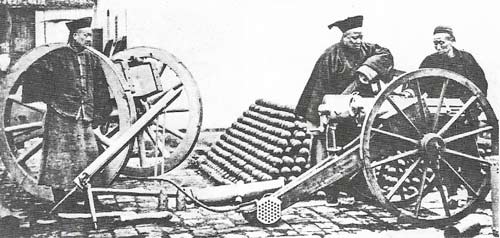
Figure 1. A “self-strengthening” movement aimed at increasing military strength to overcome Western power was launched in 1860. The buildup of armaments and improvement of railways were continued during the 1870s with moves to lay the foundation for a modern industry run by the mandarin class. Textile mills, a shipping company and an iron and steel works were established as well as smaller industries.
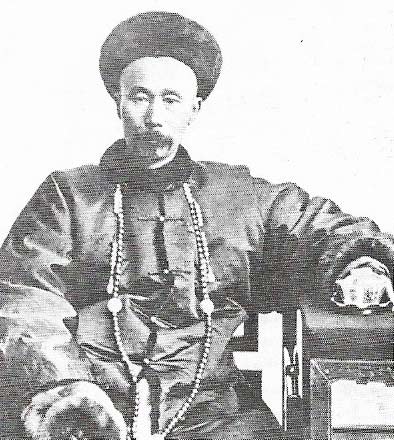
Figure 2. Li Hung-Chang (1823–1901) became China's foreign Minister after the former "Office for Barbarians" gave way to an office for "foreign matters" in 1861. He made his reputation commanding an army against the Taiping rebels and later revealed a talent for diplomacy which was acknowledged by Western powers with whom he negotiated from a position of weakness. Founder of the Chinese navy, he advanced China's interests by visiting Europe.
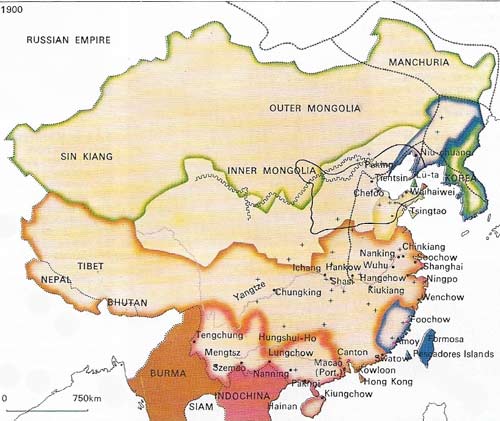
Figure 3. Foreign influence never extended to rule over China. But "treaty ports" such as Shanghai, Tientsin, and others inland were administered, policed, and taxed by foreigners. Chinese living in them were outside their government's jurisdiction. The diplomatic quarter of Peking itself was foreign administered until 1947. Towards the end of the 19th century key areas were divided up into "spheres of influence". Foreign missions and consulates abounded. While the coastal cities prospered. China's peasant economy suffered from foreign imports. Rural areas were drained of talent and the exactions of absentee landlords increased.
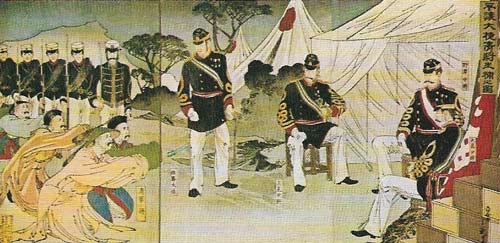
Figure 4. After the Sino-Japanese War of 1894–1895 China sued for peace (as seen in a Japanese drawing). Joining the Western powers in their demands on China, the Japanese had disrupted China's sphere of influence in Korea. In the war that followed, the Chinese were easily beaten and had to cede Formosa to Japan. This stimulated Chinese shame and nationalism more than earlier defeats inflicted by Britain and France because the Chinese had always regarded the Japanese as inferiors who had adopted Chinese culture a thousand years before. But Japan's modernisation after 1868 sent its military and industrial power far ahead.
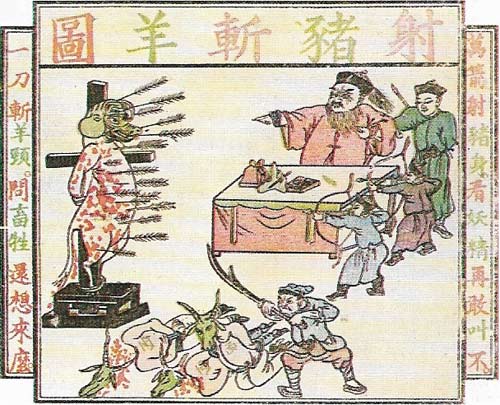
Figure 5. Chinese dislike of foreigners is shown in an 1891 cartoon of a pig as a Chinese Christian and goats as foreigners being slaughtered, earlier in the 19th century, foreigners were almost unknown; most Chinese lived and died without seeing one. Christianity made little appeal to the Chinese.
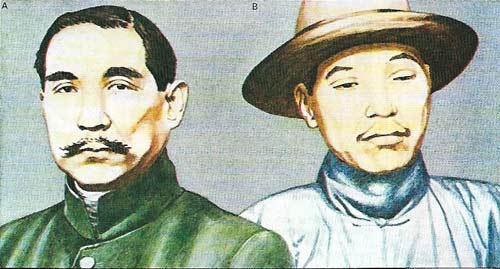
Figure 6. Intellectual leaders played a vital role in changing Chinese attitudes to the structure of government and society after the old China was swept away in the turbulence that followed the death of the Empress Dowager in 1908. The next decade brought together strands of nationalism, cultural change and revolution. Sun Yatsen (A) was an outsider to the Chinese classical tradition and the world of the mandarin. Affected by Victorian progress he wanted to modernise China. His magnetic personality built up a mixed following in the secret societies. Supported in Japan and welcomed in the West where his Christianity and good English helped, his tenacity finally won mass backing after 1919. Ch'en Tu-Hsiu (B) was a more revolutionary intellectual. When he founded the influential "New Youth" in 1915, he favored "Mr Science and Mr Democracy " but by 1922 he had emerged as the first leader of the rising Chinese Communist Party.
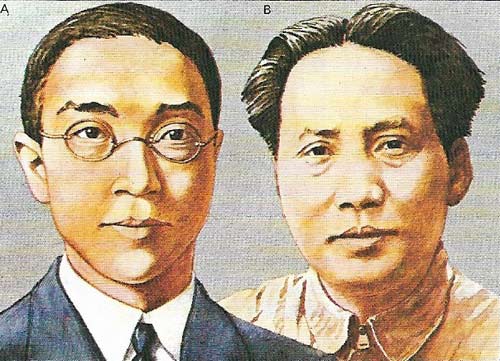
Figure 7. A revolutionary consciousness was developed in China by the teaching of men such as Hu Shih (A). He substituted the use of Classical Chinese by writers, which had separated the educated classes from others, with the vernacular. A pragmatic thinker who studied in America, he remained the spokesman of Western liberalism but influenced the future communist leader of China (B), the young Mao Tse-ting (1893–1976), who was snubbed by professors when he went to Peking University as a library assistant. For Mao's generation of students in 1919 was the year of revolutionary awakening.
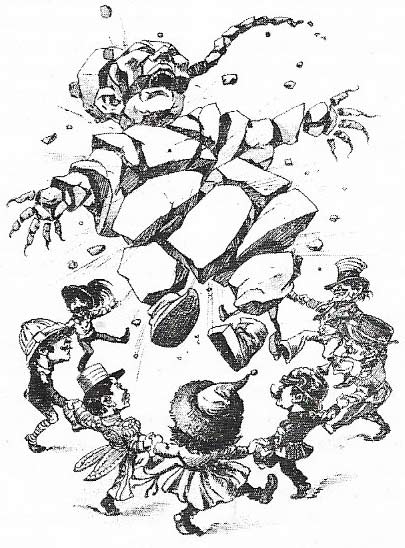
Figure 8. A common Western attitude in the nineteenth century was summed up in a cartoon of the Western powers shaking the corpulent body of a China. After the 1840 Opium War contempt for the China of the Manchu emperors began to replace the admiration held by eighteenth century Europe for the achievements of Chinese civilization. By the 1890s when nations such as Germany, Russia, Japan, Britain and France were scrambling for territorial rights, most Europeans thought "this rotten old hulk" would break up and be remade by Western enterprise. Few perceived the enduring strength of Chinese civilization beneath the decay.
Two changes in China during the nineteenth century gave that country an impetus towards the revolution that flowered in the 20th century. One that was not new in Chinese history was the decay of a dynasty – the Manchu (Ch'ing), founded in 1644. What was new, confusing and finally explosive was the challenge of Western power and technology.
The "unequal treaties"
The opening up by the West of the closed, Confucian, agrarian society of China began with the first "Opium War" of 1839–1842, during which Britain crushed a Manchu attempt to stop illegal trade in opium through Canton, then the only point of Chinese contact with the money economy of the West. The resulting Treaty of Nanking (which also gave Britain a foothold in Hong Kong) was the first of the so-called unequal treaties. They eventually forced China to grant trade and territorial rights to Western powers, legalize the trade in opium and permit missionaries (4) to spread Christianity throughout the country. After pressure by France and Britain in 1856–1860, China even had to grant Europeans a diplomatic quarter in Peking, implying equality with a country whose emperor had been a guardian of civilization for a thousand years and had always received tribute from inferior "barbarian" countries.
The disruptive impact of the West on the traditional pattern of Chinese life coincided with a chaotic situation in the countryside. Rural misery was accentuated by the massive population rise of the 18th century combined with a weak and corrupt administration which neglected its duties to maintain grain reserves and irrigation. In reaction, China was swept by a series of risings against the Manchus, beginning with the Taiping Rebellion (1850–1864). Virtually a civil war, this rising was suppressed only with the deaths of at least 25 million people in the lower Yangtze provinces. Other rebellions soon followed, such as those of the Nien in north-central China and the Chinese Muslims in the southwest and northwest, which were suppressed by 1875.
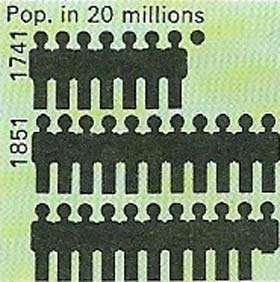 |
| China's population growth between 1750 and 1850 was immense, although the figures are unreliable. Growing land hunger in an overwhelmingly peasant economy coincided with worsening administration. |
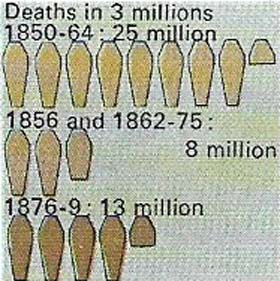 |
| Unprecedented casualties were caused by the Taiping Rebellion (1850–1864), two Muslim risings, and a north China drought in 1876–1879 which led to famine and millions of deaths by disease. |
Meanwhile, the Western-administered treaty ports, and the foreign missions spreading all over the country, steadily eroded Chinese sovereignty. In the 1860s a serious attempt was made to reinvigorate the dynasty. But this "restoration" failed to transform the conservative thinking of a court already influenced by the autocratic and dogmatic Tz'u Hsi (1835–1908) who became the Empress Dowager.
Slow technological progress
The "self-strengthening movement" that accompanied the restoration period began with the construction of arsenals, railways and dockyards in the 1860s (Figure 1) and went on with early moves for industrialization in the 1870s. But compared with Japan's speedy industrialization, China's was slow and unsure of its direction. Anti-Western feeling grew, often heightened by antagonism to Chinese "rice Christians" who took their own pickings from the privileges exacted by foreigners. Incidents in which Westerners were attacked embittered relations between the Chinese government and foreign powers. The need to learn from the West and to introduce fundamental changes was widely recognized only in 1895 when China was humiliatingly defeated by Japan (Figure 4).
In the treaty ports new middlemen in foreign trade were those patriots who knew what changes were needed. Sun Yat-sen (1866–1925), educated in Hawaii and Hong Kong, preached nationalism, and mandarins such as Kong Yii-wei (1858–1927) backed the young Kuang Hsu Emperor (reigned 1875–1908) in reform edicts in 1898. But the Empress Dowager imprisoned her son and assumed power.
The end of the old China
Competing European imperialists now threatened to partition China – a scramble halted only by an American-inspired "Open Door" policy by which the Western powers agreed to restrain their territorial ambitions in return for open trade. Meanwhile fierce anti-foreign rioting broke out in 1900 when the court diverted a rising by the secret society of the "righteous and harmonious fist" against Westerners. Known as the Boxer Rebellion, this cost the lives of nearly 250 missionaries and thousands of Chinese Christians before it was suppressed by an international army.
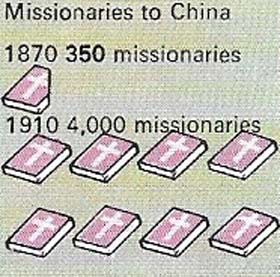 |
| Some missionaries aroused Chinese hatred and stimulated nationalism. But some, as the Welsh missionary Timothy Richard, also brought new ideas and won respect for their dedicated help. |
The old China was finished however, outmoded, and discredited. The archaic civil service examination system was abolished in 1905 and the Manchu dynasty hastily abdicated after a provincial revolt in 1911. The formula for a viable Chinese republic did not yet exist. A parliament headed by Sun Yat-sen immediately gave way to rule by a former Manchu commander, Yuan Shih-k'ai (1859–1916). A decade of rule by rival warlords followed.
The intellectual consensus needed for change was emerging, however. Sun Yatsen (Figure 6) refounded his movement as the Kuomintang Party and thousands of students educated overseas or at new universities were influenced by liberal teachers such as Ch'en Tu-Hsiu (1879–1942) and Hu Shih (1891–1962) (Figure 6). When China's weak government accepted concessions to Japan imposed after World War I (in which China had taken little part), student protest on 4 May 1919 launched a revolutionary nationalism (Figure 7) that set China alight.
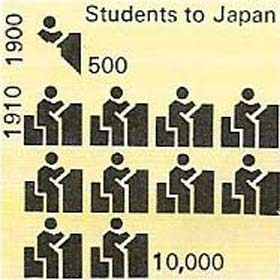 |
| Chinese students began to go to America in 1872 but the real flow to Western universities began only after 1919. Until then, Japan was a source of modern thought for a generation of Chinese. |
